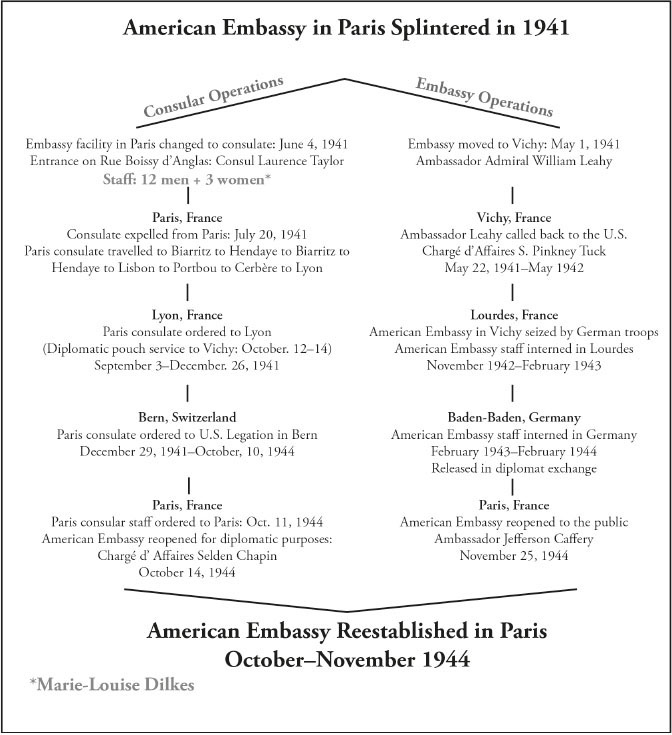
The splintering of the American Embassy in France (1941–1944)
Preface
“Quand Même” is how Marie-Louise Dilkes expressed her joy. It was her motto inscribed on a nameplate on her desk. She loved America, she loved France, and she enjoyed working for the American Embassy in Paris. She was willing to do whatever it took to keep these three loves alive in her heart and in her soul.
Personal Background
Marie-Louise Dilkes was born in Philadelphia, Pennsylvania, on March 12, 1886, and died in Paris on March 30, 1964. She was educated at the Holy Child Academy in Sharon Hill, Pennsylvania. She was a follower of Christian Science in the last 30 years of her life.
In 1917 through family connections, she volunteered to join the Emergency Aid of Pennsylvania,1 which sent her to Paris to help establish the American Soldiers’ and Sailors’ Club,2 a retreat for American soldiers from the stress of battle of the Great War. When her brother, a combat engineer in WWI, was on leave, he went to see her in Paris.3
She was the secretary for the American Soldiers’ and Sailors’ Club and worked under Dean F. W. Beekman of the American Episcopal Cathedral of the Holy Trinity in Paris.4 Marie-Louise Dilkes fell in love with Paris and stayed on after the Great War to work as a code clerk for Colonel T. B. Mott,5 Military Attaché for the American Embassy in Paris. At the conclusion of these duties, she returned to the United States and worked for the Embassy of Belgium in Washington, D.C. She was the personal secretary to the Belgian Ambassador to the United States, initially Baron de Cartier de Marchienne6 and later Prince Albert de Ligne,7 who awarded her the Croix de Chevalier de l’Ordre de Léopold II. All four of these men would recommend her for appointment as receptionist for the American Embassy in Paris. To further support her application for appointment, it is worth noting that Marie-Louise’s sister, Dolores, was married to Richard Morin8 who was Vice Consul for the American Embassy in Paris (1929–1933) and a Foreign Service officer at the U.S. Department of State in Washington, D.C. (1933–1935).
Historical Background
When Nazi Germany invaded France in June 1940, members of the French cabinet fled Paris to the Château de Cangé, then to Bordeaux, and ultimately established the French government in Vichy, which became the de facto seat of government of unoccupied France. The American Embassy stayed in Paris until May 1941 when some staff members were reassigned to establish the American Embassy in Vichy. In June 1941 the German authorities ordered all French and all foreign employees of the Embassy, including Americans, to vacate the American Embassy in Paris.9 The United States knew it still had to have a presence in Paris to address the needs of five thousand American citizens caught in the turmoil. Through negotiations with Berlin, on June 4, 1941, the American Embassy closed its main entrance on 2 Avenue Gabriel and opened the facility on June 10 as the American Consulate in Paris using the side entrance on rue Boissy d’Anglas. Twelve men and three women were assigned as staff for the now American Consulate in Paris. Marie-Louise Dilkes was one of the three women.10
This book is of her experiences as a member of the American Embassy in Paris during the dark years of 1939–1941, the American Consulate in Paris (1941), the American Consulate in Lyon (1941), and the U.S. Legation in Bern, Switzerland (1942–1944), where she was assigned after Nazi Germany took over all of France. With the success of the Allied landings in Europe in 1943–1944, the Nazi scourge was diminishing across Europe, and Germany surrendered Paris to the Allies in August 1944. At the end of August, Marie-Louise Dilkes received orders to be part of a team to reopen the American Embassy in Paris. She wrote of the triumphant reentry into France, with the help of the U.S. 7th Army, and the reestablishment of the American Embassy in Paris on October 14, 1944.
The history of the American Embassy in Paris and the splintering of its staff in 1941 into the American Consulate in Paris and the American Embassy in Vichy are outlined. Through the trials and tribulations of war, both of these components of the American Embassy were able to come together to reestablish the American Embassy in Paris by the end of 1944.

The splintering of the American Embassy in France (1941–1944)

Assignments for Marie-Louise Dilkes in WWII